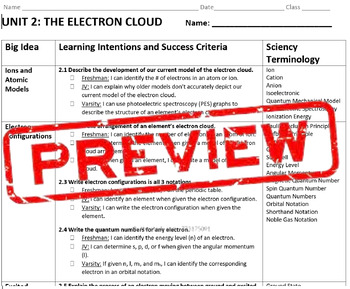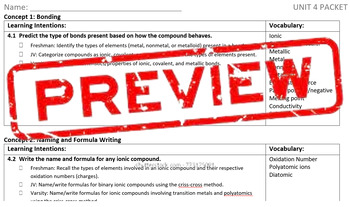Chemistry Semester 1 Learning Intentions and Success Criteria
Creative Chemistry Corner
84 Followers
Grade Levels
9th - 12th
Subjects
Resource Type
Standards
NGSSHS-PS1-8
NGSSHS-PS1-1
Formats Included
- Zip
Pages
5 pages
Creative Chemistry Corner
84 Followers
Products in this Bundle (5)
Description
This bundle includes Learning Intentions and Success Criteria for a semester of Chemistry!
5 Units included: Atomic Structure/Nuclear Chemistry, Electron Cloud, Periodic Table, Bonding, and Intermolecular Forces
Such a powerful self-assessment tool for students! Let them see how well they've mastered an objective as you move through the unit! Freshman, JV, Varsity are terms I personally use to model where they currently are on the ladder to mastering an objective. Can easily be used as bell ringers, exit tickets, and as a study outline to help them prepare for a unit test.
Also, a great resource for new teachers planning out a unit/pacing guide.
Total Pages
5 pages
Answer Key
N/A
Teaching Duration
1 Semester
Report this resource to TPT
Reported resources will be reviewed by our team. Report this resource to let us know if this resource violates TPT’s content guidelines.
Standards
to see state-specific standards (only available in the US).
NGSSHS-PS1-8
Develop models to illustrate the changes in the composition of the nucleus of the atom and the energy released during the processes of fission, fusion, and radioactive decay. Emphasis is on simple qualitative models, such as pictures or diagrams, and on the scale of energy released in nuclear processes relative to other kinds of transformations. Assessment does not include quantitative calculation of energy released. Assessment is limited to alpha, beta, and gamma radioactive decays.
NGSSHS-PS1-1
Use the periodic table as a model to predict the relative properties of elements based on the patterns of electrons in the outermost energy level of atoms. Examples of properties that could be predicted from patterns could include reactivity of metals, types of bonds formed, numbers of bonds formed, and reactions with oxygen. Assessment is limited to main group elements. Assessment does not include quantitative understanding of ionization energy beyond relative trends.





